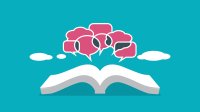5 Steps to More Effective PD With Book Studies
Educational book studies give teachers opportunities for powerful professional development built on collaboration and connection.
Your content has been saved!
Go to My Saved Content.Book studies foster collaboration, provide educators with choices for professional learning, and help teachers explore new ideas. With an explosion of educational texts coming on the market post-pandemic, educators have more book options than ever. The bones of a book study are pretty universal: pick a book, read it, discuss it, earn continuing education credit.
Through my personal experience in a dozen book studies, both as a student and as an author/guest speaker, I’ve witnessed huge differences in book study execution, leading to very different results. Based on these experiences and conversations with book study host Dr. Nikki Vradenburg, NBCT, director of education with Montana PBS, several factors emerged that elevate a basic book study to a truly meaningful professional learning experience.
1. Provide Choice
Pretty simple: Increase engagement and growth by offering choice. Compared with a district-mandated book study done for a whole staff, engagement was greater in a summer course, Vradenburg notes, “because it was the teacher who had found the book study based on their own interest and desire.”
Gather recommendations from teachers, then provide several book options. Better yet, collaborate with other districts—in your state, region, etc.—to offer even more choices and ensure diverse perspectives for discussions (see No. 2 below).
As you build your book list, acknowledge that not all books will lead to action and impact in the classroom. What’s your goal: A feel-good experience? To increase the use of best practices and drive innovation? Explore new theories and methodologies?
If you’re not sure about a book, consider these questions: After we identify with the text and perhaps feel good or inspired, then what? What’s the takeaway? How will this book shift the teaching and learning environment? How will this book help make things better for teachers? For students?
2. Ensure that you have a diverse group of educators
Exposure to new ideas and experiences is critical to helping educators grow. We don’t know what we don’t know. When surrounded by the same people every day, it’s easy to think, “This is what teaching and learning looks like.” To foster greater innovation and increased impact, seek out diverse perspectives. Combine buildings. Coordinate with other districts and cohost your book study. Reach out to a district that looks and operates differently than yours.
Not only does a mixed group of educators fuel divergent thinking, but also it helps teachers break out of their roles within their building. Vradenburg notes, “It’s too easy for us to fall into labels and then have a hard time seeing people in other roles.” Plus, when we’re surrounded by people we see every day—especially our own administration—people tend to censor themselves, Vradenburg points out. While this is respectful, it’s not always the best for growth, problem-solving, or innovation. When teachers interact with educators from outside their district, they can be seen and heard in new ways, deepening the learning experience.
3. Set clear tasks: Read this, complete this
Having a concrete task helps hold teachers accountable for their learning and ensures more vibrant discussion. This doesn’t mean micromanaging the process, just simply providing clear objectives and deadlines. This structure can also help ensure that credit is available for the book study. See my Book Club Sample Framework for ideas.
Book studies are also an effective way to model new technology tools and rethink old favorites. Use a Google Form to gather favorite quotes; use Flip to vlog about two action steps that readers will take based on that chapter; share a Jamboard or Padlet to create a thought chain; go to Mentimeter to make a word cloud.
4. Ensure opportunities to connect
Make the time to actually talk, whether virtually or in person. Self-paced, asynchronous courses are great for all the obvious reasons, but nothing matches the spark of teachers in a space together talking about their craft. Vradenburg says that the discussions in the Zoom breakout groups were vibrant and continuous. People could vent, connect, reflect, get ideas, and inspire each other far more in these conversations than they could via any writing activity.
We need each other. Despite surrounding us with people all day, teaching can be an oddly isolating profession. “We had a teacher on sabbatical/maternity leave,” Vradenburg shares, “and she chose to attend the book study because her brain needed the connection.” And, yes, our hearts need those connections too, to reenergize and reignite our passion for teaching. It’s hard, but find the time to connect.
5. Include an implementation plan
Everyone’s read the book. The book and the vigorous discussions with diverse educators filled everyone with amazing ideas. Maybe that’s enough. Maybe that’s what’s needed.
But it can also be so much more. Harness all that inspiration to drive change and improve teaching and learning. As you read, take time to identify aspects of teaching and learning that are not working—for students or teachers. Extrapolate potential solutions from the book, and use your discussions to further brainstorm ideas about what could be done instead. Provide a process for participants to work through their ideas to design something—an activity, lesson, unit, or presentation. Vradenburg uses The Educator Canvas, but use any design thinking or framework that works for your team.
The final book study meetup is then a celebration of innovative implementation ideas. Teachers share their designs and receive feedback on them. I’ve seen the tiniest seedling of an idea flourish with the questions, comments, feedback, and support of book study peers.
By including an implementation plan in the book study, you’ll elevate the uplifting, energizing experience into a purposeful exercise in problem-solving and change-making.
Book studies offer endless possibilities: Each book opens the door to new information, each reader brings their own challenges and perspectives, and each discussion ignites unlimited ideas. So go organize. And if you’d like a brainstorming buddy as you plan, please reach out.

